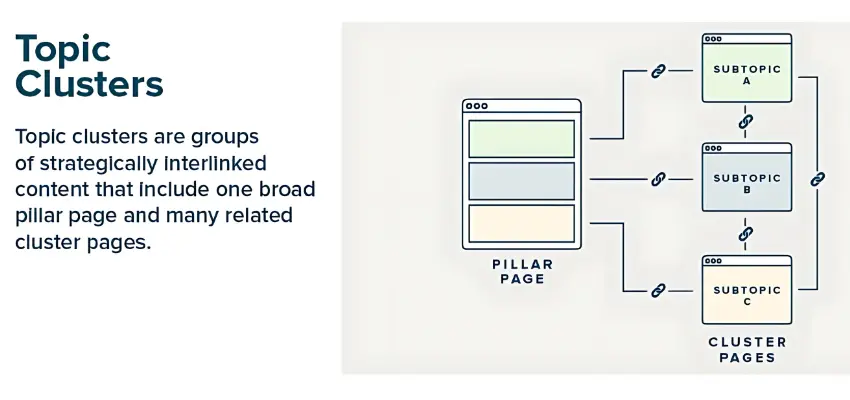In 2025, search engine optimization (SEO) is all about creating valuable content that addresses user intent and builds topical authority. Traditional keyword-focused strategies are no longer enough. Enter topic clusters—a content organization strategy that improves your site’s structure, enhances user experience, and signals authority to search engines.

What Are Topic Clusters?
A topic cluster is a group of related content pieces organized around one central pillar page. The pillar page covers a broad subject comprehensively, while cluster content focuses on subtopics, each linking back to the pillar page and to each other. This interlinked structure helps search engines understand the relationship between topics and subtopics, boosting your site’s topical authority.
Why Topic Clusters Matter in 2025
Improved SEO: Topic clusters help you rank for a broader range of keywords.
Better User Experience: Visitors can easily navigate through related content.
Boosts Topical Authority: Demonstrates to search engines that you’re an expert on the subject.
Higher Engagement: Increases dwell time and reduces bounce rates.
Learn how to improve dwell time with our Dwell Time SEO Guide.
Key Components of a Topic Cluster
1. Pillar Page
A pillar page is a comprehensive resource covering a broad topic. It provides an overview and links to more detailed subtopics (cluster pages).
Example: A pillar page on “Content Marketing” might include sections on blogging, social media, email marketing, and SEO.
2. Cluster Content
These are individual blog posts or pages that explore specific aspects of the pillar topic. Each cluster page should:
Focus on a long-tail keyword.
Link back to the pillar page.
Include internal links to other cluster pages.
3. Internal Linking Structure
Effective internal linking connects the pillar page to cluster content and vice versa. This structure helps search engines crawl your site and improves user navigation.
Quick Tip: Use descriptive anchor text when linking between pages to provide context.
Benefits of Using Topic Clusters
Enhanced SEO Performance
Search engines prefer well-structured content. Topic clusters enable you to target a wider range of keywords, improving your chances of ranking for both broad and specific search queries.
Improved User Experience
A logical content structure allows users to find relevant information quickly. This improves navigation, reduces bounce rates, and increases dwell time.
Increased Topical Authority
Covering a topic thoroughly through a pillar page and related cluster content establishes your site as a trusted and authoritative resource.
Streamlined Content Strategy
Organizing content into clusters simplifies planning and content creation, ensuring consistency and efficiency in your SEO strategy.
Bonus: Boost your keyword strategy with our Effective Keyword Research Guide.
How to Create Topic Clusters for SEO Success
1. Identify Core Topics and Subtopics
Start by selecting broad topics that align with your business goals and audience interests.
Example: If you’re an SEO agency, core topics could include “Technical SEO,” “Content Marketing,” or “Local SEO.”
2. Conduct Keyword Research
Use tools like:
Look for:
High-volume primary keywords for the pillar page.
Long-tail keywords for cluster content.
Dive deeper into long-tail keywords with our Long-Tail Keywords Guide.
3. Create the Pillar Page
Your pillar page should:
Be comprehensive (2,000+ words recommended).
Cover the main topic broadly but leave room for detailed cluster pages.
Include links to all related cluster content.
Example Pillar Topics:
“The Ultimate Guide to Local SEO”
“Content Marketing Strategies for 2025”
“Technical SEO Basics and Advanced Tips”
4. Develop Cluster Content
Write individual posts targeting subtopics. Ensure each:
Focuses on one long-tail keyword.
Provides in-depth information.
Links back to the pillar page and other relevant clusters.
Example Cluster Topics for a ‘Content Marketing’ Pillar:
“How to Create a Content Calendar for SEO”
“Content Repurposing Strategies to Maximize ROI”
“Top Tools for Content Marketing in 2025”
5. Implement Internal Linking
Link each cluster page to the pillar page.
Add links between cluster pages where relevant.
Use clear, descriptive anchor text.
Tip: Avoid generic phrases like “click here.” Use descriptive text like “learn more about content calendars.”
6. Monitor and Update Content
Track performance using:
Heatmap tools like Hotjar
Regularly update your content to keep it relevant and maintain rankings.
Need help optimizing your content clusters? Get a Free Website Audit and let our experts assist you.
Common Mistakes to Avoid
❌ Ignoring internal linking between cluster pages.
❌ Creating thin cluster content with little value.
❌ Targeting the same keyword on both pillar and cluster pages.
❌ Neglecting to update old content.
❌ Using inconsistent anchor texts.
FAQs
1. How many cluster pages should I have per pillar page?
Aim for at least 6-10 cluster pages to thoroughly cover the topic.
2. Can I have multiple pillar pages on my website?
Absolutely! Just ensure each pillar covers a unique topic.
3. How long should a pillar page be?
Typically 2,000+ words to comprehensively cover the subject.
4. How often should I update my topic clusters?
Review them every 3-6 months to ensure accuracy and relevance.
5. Do topic clusters work for small websites?
Yes! Even small sites can benefit from improved structure and SEO.
Conclusion
In 2025, topic clusters are no longer a nice-to-have—they’re essential for effective SEO. By organizing your content into pillar pages and cluster content, you can boost rankings, improve user experience, and establish your brand as a topical authority.
Start implementing topic clusters today and watch your organic traffic grow!
Ready to elevate your SEO strategy? Get a Free Website Audit and discover how topic clusters can benefit your business.
